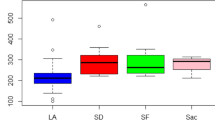Abstract
Under the Utah Prepaid Mental Health Plan, threeof the eleven Community Mental Health Centers in Utahsigned capitation contracts with the state Medicaidprogram. The capitated Centers initially accepted the risk for inpatient care, with the risklater being extended to also include outpatientservices. This study contrasts the financial experiencesof the capitated Centers and five noncontractingCenters. While various patterns of financial managementare evident in the data, it apDavid pears that thedecision to contract had, at worst, a neutral effect onoverall financial performance. Managed care programs with different designs may have differentresults.
Similar content being viewed by others
REFERENCES
American Bar Foundation. (1971). Commentaries on Model Debenture Indenture Provisions, Chicago: American Bar Foundation.
Bernstein, L. (1984). Analysis of Financial Statements, Revised Edition, Homewood, IL: Irwin.
Best Co. (1994). 1993 Best's Insurance Reports-Life-Health, Oldwick, NJ: A.M. Best Co.
Broskowski, A. and Eddy, M. (1994). Community mental health centers in a managed care environment. Administration and Policy in Mental Health, 21, 335–352.
Callahan, J., Shepard, D., Beinecke, R., Larson, M., and Cavanaugh, D. (1995). Mental health/substance abuse treatment in managed care: the Massachusetts Medicaid experience. Health Affairs, 14, 173–184.
Christianson, J., Gray, D., Kihlstrom, L., and Speckman, Z. (1995). Development of the Utah prepaid mental health plan. Advances in Health Economics and Health Services Research, 15, R. Scheffler and L. Rossiter, editors; J. Cantor, guest editor, Greenwich, CT: JAI Press, Inc., 117–135.
Cleverley W. O. (1992a). Essentials of Health Care Finance, Third Edition, Gaithersburg, MD: Aspen.
Cleverley W. O. (1992b). Financial and operating performance of systems: voluntary versus investor-owned. Topics in Health Care Finance, 18, 63–73.
Dangerfield, D. and Betit, R. (1993). Managed mental health care in the public sector. New Directions for Mental Health Services: Managed Mental Health Care, 59, W. Goldman and S. Feldman, editors, San Francisco, CA: Jossey-Bass Publishers, 41–54.
Dun and Bradstreet. (1992). Industry Norms and Key Business Ratios, One Year Edition 1991–1992, Finance, Insurance, Real Estate, Services SIC #6000–8999, New York: Duns Analytic Services.
Essock, S. and Goldman, H. (1995). States' embrace of managed mental health care. Health Affairs. 14, 34–44.
Executive Office of the President, Office of Management and Budget. (1987). Standard Industrial Classification Manual, Washington, DC: Office of Management and Budget.
Finkler, S.A. (1982). Ratio analysis: use with caution. Health Care Management Review, Spring, 65–72.
Foster, G. (1978). Financial Statement Analysis, Englewood Cliffs, CA: Prentice Hall.
Gapenski, L. (1993). Understanding Health Care Financial Management, Ann Arbor, MI: AU-PHA Press/Health Administration Press.
Kreps, C.H. and Wacht R. (1978). Analyzing Financial Statements, Fifth Edition, Washington, DC: American Bankers Association.
Myers, S. (1984). The capital structure puzzle. Journal of Finance, 39, 575-592.
National Council of Community Mental Health Centers. (1991). Business Yardsticks, An Introduction to Financial Ratios.
Sokoloff, K. (1979). The Paine Webber Handbook of Stock and Bond Analysis, Appendix III Ratio Trend Analysis, New York: McGraw-Hill.
Sorensen, J., Zelman, W., Hanbery, G., Kucic A.R. (1987). Managing mental health organizations with 25 key performance indicators. Evaluation and Program Planning, 10, 239–247.
Speckman, Z. (1992). The Medicaid Experiment Utah's Prepaid Mental Health Plan. Salt Lake City, UT: Utah Department of Health, Division of Health Care Financing.
Wyant, D., Christianson, J., and Coleman B. (1996). A Financial Analysis of the Community Mental Health Centers During the Utah Prepaid Mental Health Plan, Iowa City, Iowa Graduate Program in Hospital and Health Administration University of Iowa.
Rights and permissions
About this article
Cite this article
Wyant, D., Christianson, J. & Coleman, B. The Financial Impact on Community Mental Health Centers of Capitated Contracts with Medicaid: The Utah Prepaid Mental Health Plan. Community Ment Health J 35, 135–152 (1999). https://doi.org/10.1023/A:1018720730907
Issue Date:
DOI: https://doi.org/10.1023/A:1018720730907




